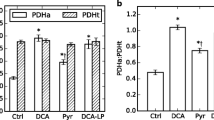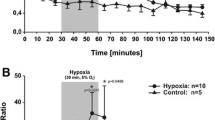Abstract
It was examined whether lactate influences postischaemic hemodynamic recovery as a function of the duration of ischaemia and whether changes in high-energy phosphate metabolism under ischaemic and reperfused conditions could be held responsible for impairment of cardiac function. To this end, isolated working rat hearts were perfused with either glucose (11 mM), glucose (11 mM) plus lactate (5 mM) or glucose (11 mM) plus pyruvate (5 mM). The extent of ischaemic injury was varied by changing the intervals of ischaemia, i.e. 15, 30 and 45 min. Perfusion by lactate evoked marked depression of functional recovery after 30 min of ischaemia. Perfusion by pyruvate resulted in marked decline of cardiac function after 45 min of ischaemia, while in glucose perfused hearts hemodynamic performance was still recovered to some extent after 45 min of ischaemia. Hence, lactate accelerates postischaemic hemodynamic impairment compared to glucose and pyruvate. The marked decline in functional recovery of the lactate perfused hearts cannot be ascribed to the extent of degradation of high-energy phosphates during ischaemia as compared to glucose and pyruvate perfused hearts. Glycolytic ATP formation (evaluated by the rate of lactate production) can neither be responsible for loss of cardiac function in the lactate perfused hearts. Moreover, failure of reenergization during reperfusion, the amount of nucleosides and oxypurines lost or the level of high-energy phosphates at the end of reperfusion cannot explain lactate-induced impairment. Alternatively, the accumulation of endogenous lactate may have contributed to ischaemic damage in the lactate perfused hearts after 30 min of ischaemia as it was higher in the lactate than in the glucose or pyruvate perfused hearts. It cannot be excluded that possible beneficial effects of the elevated glycolytic ATP formation during 15 to 30 min of ischaemia in the lactate perfused hearts are counterbalanced by the detrimental effects of lactate accumulation.
Similar content being viewed by others
References
Van Bilsen M, van der Vusse GJ, Snoeckx LHEH, Arts T, Coumans WA, Willemsen PHM, Reneman RS: Effects of pyruvate on postischaemic myocardial recovery at various workloads. Pflügers Archiv-Eur J Physiol 413: 167–173, 1988
Bünger R, Mallet RT, Hartman DA: Pyruvate-enhanced phosphorylation potential and inotropism in normoxic and postischaemic isolated working heart. Eur J Biochem 180: 221–233, 1989
De Groot MJM, Van der Vusse GJ: The effect of lactate on ischaemic and reperfused hearts. Pflügers Archiv-Eur J Physiol 416: S5, 1990
Armiger LC, Herdson PB, Gavin JB: Mitochondrial changes in dog myocardium induced by neutral lactate in vitro. Laboratory Invest 31: 29–33, 1974
Armiger LC, Seelye RN, Phil D, Elswijk JG, Carnell VM, Benson DC, Gavin JB, Herdson PB: Mitochondrial changes in dog myocardium induced by lactate in vivo. Laboratory Invest 33: 502–508, 1975
Armiger LC, Seelye RN, Phil D, Elswijk JG, Carnell VM, Gavin JB, Herdson PB: Fine structural changes in dog myocardium exposed to lowered pH in vivo. Laboratory Invest 37: 237–242, 1977
Messin R: Peripheral lactic acid production in heart disease. In: PR Moret, J Weber, JC Haissly, H Denolin (eds.) Lactate physiologic, methodologic and pathologic approach. Springer Verlag Berlin, 1980, pp 163–173
Waters WC, Hall JD, Schwartz WB: Spontaneous lactic acidosis. The nature of the acid-base disturbance and considerations in diagnosis and management. Am J Med 35: 781–793, 1963
Reibel DK, Rovetto MJ: Myocardial ATP synthesis and mechanical function following oxygen deficiency. Am J Physiol 234: H620-H624, 1978
Reimer KA, Jennings RB: Energy metabolism in the reversible and irreversible phases of severe myocardial ischaemia. Acta Med Scand 651: 19–27, 1981
Zimmer HG: Normalization of depressed heart function in rats by ribose. Science 220: 81–82, 1983
Opie LH: Myocardial ischaemia- metabolic pathways and implications of increased glycolysis. Cardiovasc Drugs Ther 4: 777–790, 1990
Zimmer HG, Trendelenburg C, Kammermeier H, Gerlach E: De novo synthesis of myocardial adenine nucleotides in the rat. Acceleration during recovery from oxygen deficiency. Circ Res 32: 635–642, 1973
Van Belle H, Goossens F, Wynants J: Formation and release of purine catabolites during hypoperfusion, anoxia, and ischaemia. Am J Physiol 252: H886-H893, 1987
De Jong JW, Achterberg PW: ATP-metabolism in normoxic and ischaemic heart. In: JW de Jong (ed.) Myocardial Energy Metabolism. Martinus Nijhoff Publ Dordrecht, 1988, pp 3–7
Van Bilsen M, Van der Vusse GJ, Coumans WA, De Groot MJM, Willemsen PHM, Reneman RS: Degradation of adenine nucleotides in ischaemic and reperfused rat heart. Am J Physiol 257: H47-H54, 1989
Bünger R, Soboll S: Cytosolic adenylates and adenosine release in perfused working heart. Eur J Biochem 159: 203–213, 1986
Bünger R, Mallet RT, Hartman DA: Redox manipulation of free cardiac adenylates and purine nucleoside release. Reciprocity between cytosolic phosphorylation potential and reduction-oxidation state of free AMP in perfused working heart. In: JW De Jong (ed.) Myocardial Energy Metabolism. Martinus Nijhoff Publ, Dordrecht, 1988, pp 67–81
Zucchi R, Limbruno U, Poddighe R, Mariani M, Ronca G: Purine release from isolated rat heart: a new approach to the study of energy metabolism. J Mol Cell Cardiol 22: 815–826, 1990
Achterberg PW, Harmsen E, De Jong JW: Adenosine deaminase inhibition and myocardial purine release during normoxia and ischaemia. Cardiovasc Res 10: 593–598, 1985
De Groot MJM, Willemsen PHM, Coumans WA, Van Bilsen M, Van der Vusse GJ: Lactate-induced stimulation of myocardial triacylglycerol turnover. Biochim Biophys Acta 1006: 111–115, 1989
Van Bilsen M, Snoeckx LHEH, Arts T, Van der Vusse GJ, Reneman RS: Performance of the isolated, ejecting heart: effects of aortic impedance and exogenous substrates. Pflügers Archiv-Eur J Physiol 419: 7–12, 1991
Snoeckx LHEH, Van der Vusse GJ, Coumans WA, Willemsen PHM, Van der Nagel T, Reneman RS: Myocardial function in normal and spontaneously hypertensive rats during reperfusion after a period of global ischaemia. Cardiovasc Res 20: 67–75, 1986
Van der Vusse GJ, Coumans WA, Van der Veen FH, Drake A, Flameng W, Suy R: ATP, creatine phosphate and glycogen content in human myocardial biopsies: markers for the efficacy of cardioprotection during aorta-coronary bypass surgery. Vase Surg 18: 127–134, 1984
Wijnants J, Van Belle H: Single-run high performance liquid chromatography of nucleosides and major purine bases and its application to different tissue extracts. Anal Biochem 144: 258–266, 1985
Passoneau J: Fluorometric method for the determination of lactate with LDH. In: HU Bergmeyer (ed.) Methods of enzymatic analysis. Verlag Chemie GmbH, Weinheim, 1974, Vol 3, pp 1468–1472
Harmsen E, De Jong JW, Serruys PW: Hypoxanthine production by ischaemic heart demonstrated by high pressure liquid chromatography of blood purine nucleosides and oxypurines. Clin Chim Acta 115: 73–84, 1981
Mochizuki S, Neely JR: Energy metabolism during reperfusion following ischaemia. J Physiol 76: 805–812, 1980
Neely JR, Grotyohann LW: Role of glycolytic products in damage to ischemic myocardium. Dissociation of adenosine triphosphate levels and recovery of function of reperfused ischemic hearts. Circ Res 55: 816–824, 1984
Bindoli A, Cavallini L, Rigobello MP, Coassin M, Di Lisa F: Modification of the xanthine-converting enzyme of perfused rat heart during ischaemia and oxidative stress. Free Radical Biol Med 4: 163–167, 1988
Bolli R: Oxygen-derived free radicals and postischaemic myocardial dysfunction (‘stunned myocardium’). J Am Coll Cardiol 12: 239–249, 1988
Kloner RA, Przyklenk K, Whittaker P: Deleterious effects of oxygen radicals in ischaemia/reperfusion. Circ 80: 1115–1127, 1989
Mowbray J, Hutchinson WL, Tibbs GR, Morris PG: The discovery of a rapidly metabolized polymeric tetraphosphate derivative of adenosine in perfused rat heart. Biochem J 223: 627–632, 1984.
Author information
Authors and Affiliations
Rights and permissions
About this article
Cite this article
de Groot, M.J.M., Coumans, W.A. & van der Vusse, G.J. The nucleotide metabolism in lactate perfused hearts under ischaemic and reperfused conditions. Mol Cell Biochem 118, 1–14 (1992). https://doi.org/10.1007/BF00249689
Received:
Accepted:
Issue Date:
DOI: https://doi.org/10.1007/BF00249689




